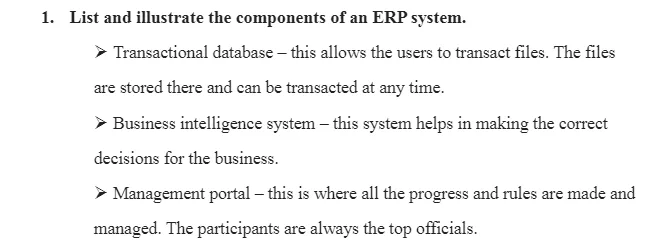ERP Implementation and Microsoft Dynamics
Part 1: Answer the module review questions listed below. These questions were chosen to demonstrate your understanding and help you assess your progress.
- List and illustrate the components of an ERP system.
- Define third-part products and why are they needed?
- What is an implementation methodology and why is it important in ERP implementations?
- Explain the steps in purchasing an ERP.
- What is total cost of ownership (TCO) and why should it be a part of the ERP selection process?
- Contrast the difference between an RFI and RFB.
Part 2: Using the below elements of TCO, create two scenarios; the first where the TCO is in favor of in-house development; and the second scenario, where TCO is in favor of a software acquisition through a vendor.
- License & Subscription
- Installation & Set-up
- Customization & Integration
- Data migration
- Training
- Maintenance & Support
- Hardware
- Other
Part 3
Defined and documented functional requirements are a part of the bid process. Discuss why this would be beneficial in the selection of an ERP system even if a bid is not required. Justify your answer.
Part 4
Microsoft Dynamics is a collection of popular ERP system used by many organizations. Dynamics offer five primary products, each includes one or more model. The primary products are: Microsoft Dynamics AX, Microsoft Dynamics GP, Microsoft Dynamics NAV, Microsoft Dynamics SL, and Microsoft Dynamics CRM.
Write a minimum of three (3) page research report, using current APA formatting. The report should cover:
-
- the previously listed MS Dynamics ERP systems,
- a description of each ERP,
- list and description of each associated models,
- intended purpose of each ERP and model(s),
- pricing, and
- other relevant technical and functional data.
At the end of the report, create a separate section and write your own reflection of MS Dynamics. Your report should include proper references.
Answer Preview-ERP Implementation and Microsoft Dynamics

